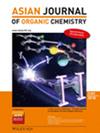Recent Advances in the Chemistry of 5 and 6‐Membered Selenacycles and Selenaheterocycles
IF 2.8
4区 化学
Q1 CHEMISTRY, ORGANIC
引用次数: 0
Abstract
In recent years, selenium and selenium‐containing compounds have attracted increasing attention due to their fascinating biological activities and synthetic versatility. This review aims to highlight the recent advances in the chemistry of cyclic structures incorporating this valuable yet rare heteroatom. Special emphasis is given to 5‐ and 6‐membered rings containing selenium, including combinations with other heteroatoms such as oxygen and nitrogen. To provide a comprehensive and up‐to‐date overview, we have summarized contributions reported between 2020 and 2024, addressing both synthetic methods and medicinal chemistry aspects where relevant. Following an introductory section, the review explores the chemistry of 5‐membered rings, including selenophenes, benzo(heteroaryl)selenophenes, and tetrahydroselenophenes. Subgroups such as 1,3‐selenazoles and 1,3‐oxaselenolanes are discussed in detail, alongside a dedicated analysis of benzisoselenazolones. Among these, ebselen—a prototypical benzisoselenazolone and one of the most extensively studied selenium‐based compounds—is given particular attention. The discussion then shifts to 6‐membered rings, encompassing among others selenomorpholines, 1,3‐selenazinanes, 1,2,4‐selenadiazinanes, and tetrahydro‐2H‐selenopyranes, with a focus on their unique chemical properties and potential applications. The review concludes with a summary and an outlook on future research directions in this evolving field.
5元和6元硒环和硒杂环的化学研究进展
近年来,硒及其含硒化合物因其具有丰富的生物活性和广泛的合成用途而受到越来越多的关注。本文综述了近年来含这种稀有杂原子的环结构的化学进展。特别强调的是含硒的5元和6元环,包括与其他杂原子如氧和氮的组合。为了提供全面和最新的概述,我们总结了2020年至2024年间报道的贡献,涉及合成方法和药物化学方面的相关内容。在介绍部分之后,综述探讨了5元环的化学性质,包括硒烯、苯并(杂芳基)硒烯和四氢硒烯。详细讨论了1,3‐硒化唑类和1,3‐草硒化烯烷类亚群,并对苯并异硒化唑类进行了专门分析。其中,ebsela -一种典型的苯并异硒唑酮,也是研究最广泛的硒基化合物之一-被特别关注。然后讨论转向6元环,其中包括selomorpholines, 1,3 - selenazinanes, 1,2,4 - selenadiazinanes和tetrahydro - 2H - selenopyranes,重点是它们独特的化学性质和潜在的应用。最后,对该领域的研究方向进行了总结和展望。
本文章由计算机程序翻译,如有差异,请以英文原文为准。
求助全文
约1分钟内获得全文
求助全文
来源期刊

Asian Journal of Organic Chemistry
CHEMISTRY, ORGANIC-
CiteScore
4.70
自引率
3.70%
发文量
372
期刊介绍:
Organic chemistry is the fundamental science that stands at the heart of chemistry, biology, and materials science. Research in these areas is vigorous and truly international, with three major regions making almost equal contributions: America, Europe and Asia. Asia now has its own top international organic chemistry journal—the Asian Journal of Organic Chemistry (AsianJOC)
The AsianJOC is designed to be a top-ranked international research journal and publishes primary research as well as critical secondary information from authors across the world. The journal covers organic chemistry in its entirety. Authors and readers come from academia, the chemical industry, and government laboratories.
 求助内容:
求助内容: 应助结果提醒方式:
应助结果提醒方式:


